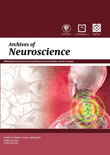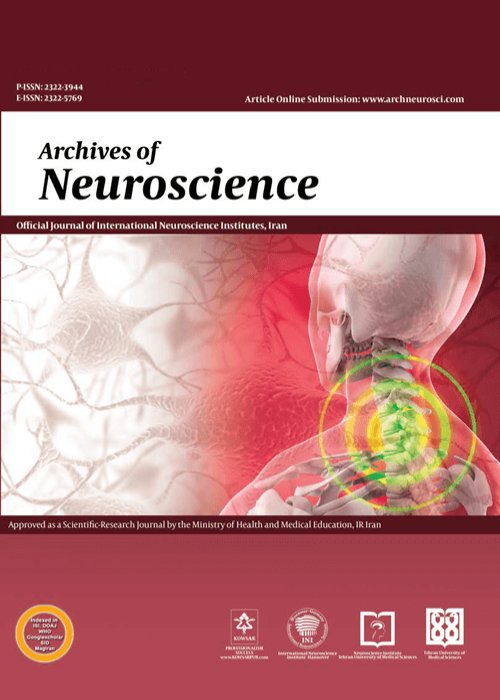فهرست مطالب

Archives of Neuroscience
Volume:4 Issue: 1, Jan 2017
- تاریخ انتشار: 1395/10/29
- تعداد عناوین: 10
-
-
Page 1Context: Neuropathic pain (NP) is a chronic debilitating painful condition with complex pathophysiology and inadequate treatment. Conventional pharmacological approaches and currently available drugs only provide marginal pain relief and cause significant adverse effects. The present manuscript is an attempt to summarize the existing data and possible pharmacological approaches available for NP..
Evidence Acquisition: Information was collected from Google Scholar, Cochrane and PubMed databases, Scopus and directory of open access journals. Neuropathic pain, chronic pain, diabetic neuropathy, pathophysiology and current recommendations were the terms used to search the literature. Data from relevant animal and randomized controlled studies were selected to get the up to date information of the currently available pharmacological approaches. A note on future approaches was added based on the recent animal and human studies..ResultsThe current review made a significant attempt to focus on the mode of action, required dosage, advantages and the side effect profiles of currently available drugs used, or in investigational phases and their possible combinations to manage NP. Efforts are made to cover arise of NP because of diabetes and its management. At the end, authors made an attempt to cover the various therapeutic options that are currently explored for future drug development..ConclusionsThe available pharmacological approaches are effective on one or other types of chronic pain. But the inadequate pain relief and limitations with each class of drugs raises the need to develop better therapeutic approaches and also understand the pathology better. The present review may be helpful to researchers intending to focus on newer therapeutic strategies and targets to manage NP..Keywords: Chronic Pain, Antidepressants, Anti, Epileptics, Opioids, Therapeutic Management -
Page 2Context: Trigeminal nerve stimulation (TNS) is a promising non-invasive brain stimulation intervention. The TNS has been proposed for major depressive disorder (MDD) with auspicious results. The aim of this study was to review the literature on TNS for MDD..
Evidence Acquisition: Systematic review, using MEDLINE and EMBASE, of first articles available until 22nd of April 2016..ResultsWe included seven studies; six of them were open-label studies and one sham-controlled randomized double-blinded trial. Most studies had small sample sizes. Two studies were on MDD with comorbid posttraumatic stress disorder and one study focused on the elderly population. Two different protocols of stimulation were reported. Studies had interesting positive results for treating MDD..ConclusionsThe TNS was reported to be well tolerated, with no severe adverse effect reported, and had impressive results for MDD. This promising, safe and easy-to-use new neuromodulation technique could be a useful tool for MDD treatment. However, the results reported in the studies performed so far must be analyzed under the strict limitations of the study design. Most of the studies on TNS are case studies or open-label trials with very small sample sizes. We acknowledge that it is the time to initiate more rigorous sham-controlled trials to better understand the huge potential involved with this technique, which could lead to the development of more accessible, easy-to-use, safe and non-invasive technology..Keywords: Depression, Major Depressive Disorder, Trigeminal Nerve Stimulation, Cranial Nerve Stimulation, Non, Pharmacological Therapies, Systematic Review -
Page 3BackgroundEvidences show that generally stroke patients receiving greater amount of physiotherapy obtain better motor function over time, although this has not been investigated in the early post stroke population. The aim of the present observational retrospective study was to investigate the relationship between the amount of physiotherapy provided to early post acute stroke patients and their motor improvement..MethodsOverall, 846 early stroke patients with hemiparesis, treated with physiotherapy, were retrospectively analyzed. Clinical data at admission as well as functional scales at the first evaluation and at discharge were analyzed. For each patient, a rehabilitation load (resulting from the total number of the 30 daily consecutive physiotherapy sessions they received) was used as the dose of physiotherapy. Pre and post rehabilitation scales were analyzed and their change (Δ) was correlated with the rehabilitation load..ResultsThe mean rehabilitation load was ten sessions (range 2 to 56). The scores of Barthel index, Motor Assessment Score, Motricity index for both lower and upper limb, Functional Ambulation Classification, Berg Balance scale and Trunk control test significantly improved from pre to post rehabilitation, and a significant correlation was found between the rehabilitation load and the improvement in Barthel index (PConclusionsIn this study, a significant correlation was found between early post stroke motor rehabilitation dose and greater improvement in functional scales, assessing patients independence, balance and paretic limbs motricity..Keywords: Stroke, Rehabilitation, Hemiparesis
-
Page 4BackgroundAddiction is described as a condition in which individuals are not able to control their drug use despite long-term negative consequences. Non-drug addiction or behavioral addiction such as exercise can mimic similar physiological changes in the brain and reward circuit enhancement. Psychological dependence of drug abuse, which is characterized by drug seeking behaviors will develop an ongoing cycle of drug withdrawal and relapse. Moreover, exercise has two bimodal effects; it may decrease drug seeking in a physiologic range and it may increase drug seeking when it is taken in large quantity. The current study aimed to investigate and compare the effects of voluntary and compulsory exercise on male rats tendency towards using morphine..MethodsWe included 32 male rats that were 2 months of age. After 2-weeks of compulsory and voluntary exercise, all rats were exposed to 5-day conditioned place preference (CPP) in order to evaluate drug-seeking behavior. The CPP scale was obtained by comparing the data from pre-conditioning and post-conditioning phases and it was used to evaluate morphine-dependence..ResultsThe results of the current study showed that the rats that received compulsory exercise had significantly less tendency towards morphine (PConclusionsWe conclude that compulsory exercise may reduce psychological dependence on morphine and could also be regarded as a proper complementary method for addiction prevention and preventing relapse..Keywords: Compulsory Exercise, Voluntary Exercise, Conditioned Place Preference, Morphine, Rat
-
Page 5BackgroundThe auditory verbal learning test (AVLT) procedure is routinely deployed in neuropsychological investigations to examine learning and memory status in research and clinical cohorts. Concerns however have been raised regarding the susceptibility of the standard AVLT procedure to ceiling effects, which may have adverse consequences for psychometric properties and result in an underestimation of true potential and differences between normal and abnormal scores..MethodsWe examined the performance of patients with temporal lobe epilepsy (TLE; n = 40) who had completed a standard 15-item AVLT and compared a group of TLE patients (n = 12) with healthy controls (n = 12) who completed an extended 24-item AVLT, which was designed to minimise the probability of ceiling scores..ResultsCeiling effects on at least one trial (≥ 14) was achieved by 33% of patients on the 15-item test, with 60% of patients scoring within or above the average list learning total score. Increasing the list length to 24-items reduced the percentage of TLE patients scoring within the normal range to 42%. In addition, no patients but 25% of control participants achieved a maximum score on trial A5. The performance of controls was superior to patients for the best learning trial, learning rate and total learning score..ConclusionsIncreasing the list length to 24-items eliminated ceiling scores in all TLE patients and most controls and allowed the true magnitude in difference between the groups to be observed. These findings have implications for decisions relating to optimal AVLT list lengths that might be deployed for memory assessment in TLE..Keywords: Verbal Learning, Neuropsychological Test, Memory, Temporal Lobe Epilepsy
-
Page 6Assessments of attractiveness underlie selection and pursuit of potential mates. Previous research has shown that people are sometimes perceived to be more attractive with a brief glimpse, yet there is no explanation for why this effect might exist. Here, participants rated the attractiveness of males and females photographs, viewed in two conditions: once for 225 ms, and once without time constraints. In the former case, attractiveness judgments were on average higher: briefly glimpsed people were judged to be more attractive. This glimpse effect was most pronounced when males rated photos of females. We discuss several possible explanations for these results, including the speculation that the brain determines attractiveness based on Bayesian risk, in which attractiveness ratings are upwardly biased by the high cost of missing a potential mate..Keywords: Glimpse, Glimpse Effect, Attractiveness, Beauty, Bayesian
-
Page 7Parallel mathematical descriptions of behavioral structures across species are not necessarily associated with parallel cognitive outcomes. The present discussion provides an analysis of the mechanisms that might be involved in generating such superficial parallel behaviours and sketches a theoretical framework to outline a possible way of understanding cognitive superiority in humans as a qualitative difference. Piagets version of recapitulation theory is the focus of this study, which will be presented in three main sections: first a thought experiment will demonstrate that Piagets version of recapitulation leads to a logical difficulty in explaining cognitive outcomes based on parallel behaviors across species. Then, examples of different brain areas that might be involved in generating such superficial parallel structures in spatial navigation will be discussed and finally a theoretical framework will be proposed to demonstrate how a redirection from Piagets focus on the behaviour as the motor of evolution to a consideration of the division of labour in the brain would potentially explain the superior cognitive outcomes in humans based on the abstraction of computational patterns generated by neuronal firing in relevant brain areas..Keywords: Cognitive Evolution, Exploration, Spatial Cognition, Spatial Navigation, Recapitulation, Logic of Neural Network, Group Theory, Primate, Rodent


